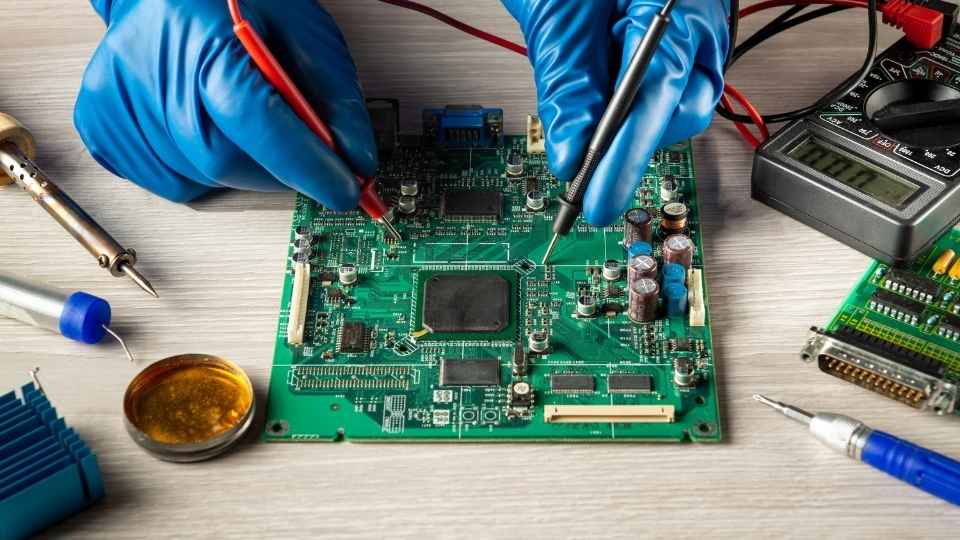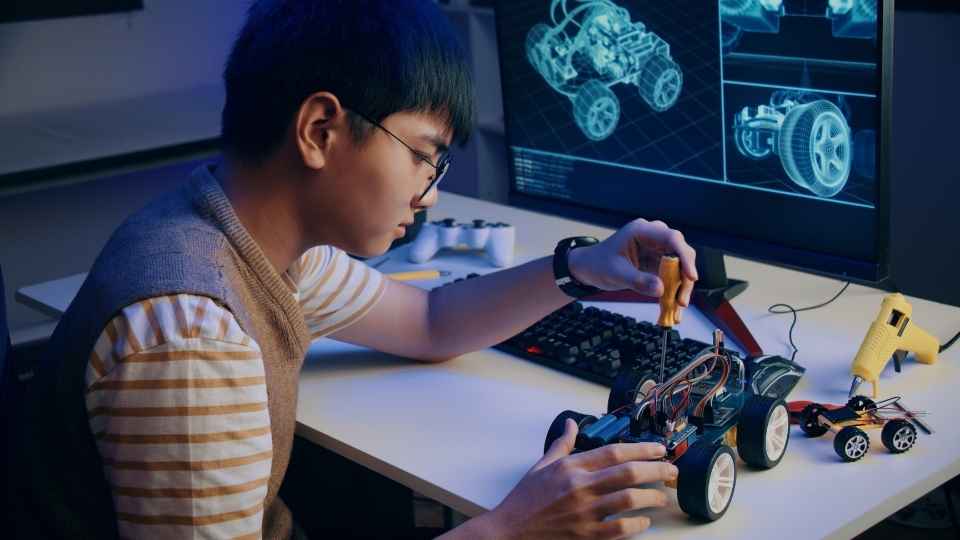
In this era of technological advancement, where autonomy and artificial intelligence dominate the landscape, the future of robot programming lies in open-source software.
The paradigm shift towards collaborative development has allowed for increased flexibility, customization, and innovation in the world of robotics.
This article delves into the advantages and disadvantages of open-source software for robots, explores various open-source robot programming languages and platforms, examines the role of open-source communities in driving progress, and discusses the challenges and opportunities that lie ahead for this liberating approach to robot programming.
Key Takeaways
- Open-source software revolutionizes the industry by providing accessible and collaborative platforms for developers, fostering innovation and experimentation.
- Open-source software eliminates licensing costs associated with proprietary solutions, making it cost-effective.
- Open-source languages like Python, C++, and JavaScript offer flexibility for customization and integration with various hardware platforms.
- Open-source communities drive development and innovation in robot programming, enabling collaboration, knowledge sharing, and collective problem-solving.
The Rise of Open-Source Software in Robot Programming
The rise of open-source software in robot programming has revolutionized the industry by providing accessible and collaborative platforms for developers to share and improve upon code. Open-source software refers to programs whose source code is freely available, allowing users to modify and distribute it as they see fit. This approach empowers developers with the freedom to customize robot programming according to their specific needs, without being bound by proprietary restrictions.
Open-source platforms like ROS (Robot Operating System) have gained widespread popularity due to their flexibility and extensive libraries. Developers can leverage existing code repositories, such as GitHub, which host a vast collection of open-source projects related to robotics. This fosters collaboration among programmers worldwide, encouraging knowledge sharing and collective problem-solving.
Additionally, open-source software encourages innovation by enabling rapid prototyping and experimentation. Developers can quickly iterate on ideas, building on top of existing frameworks rather than starting from scratch. The open nature of these platforms also facilitates integration with other technologies, promoting interoperability within the robotics ecosystem.
Advantages and Disadvantages of Open-Source Software for Robots
One major benefit of utilizing open-source solutions in the field of robotics is the ability to tap into a vast and collaborative community that continuously enhances and expands the capabilities of these software systems.

Open-source software for robots offers several advantages, such as freedom and flexibility in customization, cost-effectiveness, and transparency. Developers have the liberty to modify and optimize the code according to specific requirements without any restrictions. This allows for greater control over the robotic system's behavior and functionality.
Additionally, open-source software eliminates licensing costs associated with proprietary solutions, making it an economically viable option for both individuals and organizations. The transparency of open-source codes enables developers to identify potential vulnerabilities or bugs easily, leading to faster bug fixes and increased security.
However, it is important to note that open-source software may also pose challenges such as compatibility issues or limited support options that need careful consideration before implementation.
Open-Source Robot Programming Languages: A Comprehensive Overview
Open-source robot programming languages provide developers with a comprehensive set of tools and libraries for designing, controlling, and simulating robotic systems. These languages offer the flexibility to customize and modify code according to specific requirements, enabling seamless integration with various hardware platforms.
This overview will discuss the benefits of open-source programming in this context and highlight some popular open-source languages commonly used by robotics enthusiasts and professionals alike.
Benefits of Open-Source
Advantages of utilizing open-source software in robot programming include increased flexibility, cost-effectiveness, and a collaborative community for continuous improvement.
Open-source software allows developers to modify and customize the code according to their specific requirements, providing unparalleled flexibility. This enables them to create unique solutions tailored to their needs without being limited by proprietary restrictions.

Moreover, open-source software eliminates the need for expensive licensing fees associated with proprietary alternatives, making it an extremely cost-effective solution for robot programming.
Additionally, the collaborative nature of open-source communities fosters knowledge sharing and innovation. Developers can benefit from the collective expertise of a diverse community that continuously contributes improvements and enhancements.
The freedom offered by open-source software empowers programmers to take control of their projects and adapt them as technology evolves, ensuring long-term sustainability and growth in the field of robot programming.
Popular Open-Source Languages
A variety of programming languages have gained significant popularity among developers in the open-source community. These languages offer a range of features and capabilities that cater to the specific needs of robot programming.
One such popular language is Python, known for its simplicity and readability. Its extensive libraries provide ample support for various tasks, making it an ideal choice for robotic applications.
Another widely used language is C++, which offers high performance and low-level control, allowing developers to optimize their code for efficiency.
For those interested in web-based robot programming, JavaScript has emerged as a favored option due to its versatility and compatibility with modern browsers.

Additionally, ROS (Robot Operating System) provides a flexible framework that supports multiple languages including Python and C++, enabling seamless integration between different components of a robotic system.
These open-source languages empower developers with the freedom to choose the tools that best suit their requirements while fostering collaboration within the robotics community.
When evaluating robot software platforms, it is crucial to consider which one aligns best with your specific needs and goals. Open-source robot software platforms offer a range of options that provide developers with the freedom to customize and extend their capabilities.
One popular platform is ROS (Robot Operating System), which offers a comprehensive set of tools and libraries for building robotic systems. The modular nature of ROS allows for easy integration of different components, making it suitable for complex robotics projects.
Another option is Gazebo, a 3D simulation environment that enables realistic testing and development of robot algorithms.
For those interested in machine learning, TensorFlow can be used to train and deploy models on robots.
Ultimately, the choice depends on factors such as project requirements, community support, documentation, and compatibility with existing hardware or software infrastructure.

The Collaborative Future: Open-Source Communities in Robot Programming
The collaborative future of robot programming lies in the open-source communities that drive development and innovation.
These communities bring together experts from around the world to collaborate on building and improving robot programming software, sharing knowledge, and creating a collective intelligence.
Through this collaborative approach, the possibilities for advancements in robot programming are limitless, fostering a dynamic ecosystem where ideas can flourish and progress can be made at an accelerated pace.
Benefits of Open-Source
One significant advantage of open-source software in robot programming is its ability to foster collaboration and innovation among developers.
Open-source platforms enable programmers to freely access, modify, and distribute source code, allowing for a more transparent and inclusive development process.
With open-source software, developers can collaborate across geographical boundaries, sharing their knowledge and expertise to enhance the capabilities of robotic systems. This collaborative approach promotes the exchange of ideas and encourages continuous improvement, resulting in faster problem-solving and accelerated innovation cycles.
Additionally, open-source software empowers users with the freedom to customize and adapt robot programming according to their specific needs and preferences.

This flexibility not only enables individual creativity but also encourages a sense of ownership within the community.
Such benefits lay the foundation for community-driven development where contributors actively participate in shaping the future of robot programming by collectively contributing their skills and insights into building robust solutions.
Collaborative contributions from a diverse range of developers shape the evolution and advancement of robotic systems through community-driven development. In the realm of open-source robot programming, this model has proven to be highly effective in fostering innovation and driving progress.
By embracing community-driven development, developers are able to tap into a vast pool of expertise and ideas, allowing for rapid problem-solving and iteration. This collaborative approach encourages knowledge sharing, transparency, and a sense of ownership among participants. It also empowers individuals to customize and adapt robot software to suit their specific needs or preferences, promoting freedom and flexibility.
Additionally, community-driven development ensures that the software remains up-to-date with emerging technologies and industry trends as contributors continuously enhance the codebase based on real-world feedback. This inclusive ecosystem enables the future growth and adoption of open-source robotics software while nurturing a vibrant community dedicated to pushing boundaries in robot programming.
Collaboration in Robot Programming
In the realm of collaborative development, programmers come together to exchange ideas and expertise, fostering innovation and driving progress in the field of robotics. The open-source nature of robot programming allows for a community-driven approach, where individuals contribute their skills and knowledge to develop powerful software solutions.
Here are four key aspects of collaboration in robot programming:

Knowledge sharing: Collaborative platforms enable programmers to share their insights, experiences, and best practices with others, helping to expand the collective understanding of robot programming.
Code collaboration: Through version control systems like Git, developers can work together on codebases, making it easier to manage complex projects and ensuring that all contributors have access to the latest updates.
Bug fixing and improvement: By collaborating on open-source projects, programmers can identify bugs or areas for improvement more quickly and efficiently. This enables continuous development and enhances the overall quality of the software.
Community engagement: Collaboration fosters a sense of community among robot programmers who share similar goals and interests. This sense of belonging encourages participation, feedback sharing, and ultimately drives further innovation in the field.
Challenges and Opportunities: The Road Ahead for Open-Source Robot Programming
The future of open-source software in robot programming presents a multitude of challenges and opportunities as we navigate the road ahead.
One of the primary challenges is ensuring compatibility and interoperability between different open-source platforms. With numerous frameworks, libraries, and languages available, it becomes crucial to establish standardized protocols to enable seamless integration across systems.
Additionally, maintaining security in an open-source environment is another significant challenge. As more developers contribute code, there is an increased risk of vulnerabilities being introduced. Robust code review processes and regular updates are essential to address these concerns.

However, open-source software also brings several opportunities for innovation and collaboration. The freedom to modify and distribute code allows developers worldwide to work together on creating advanced robot programming solutions. This collaborative approach fosters creativity, accelerates development cycles, and encourages knowledge sharing within the community.
Frequently Asked Questions
How Can Open-Source Software Contribute to Advancements in Robot Programming?
Open-source software contributes to advancements in robot programming by fostering collaboration, knowledge sharing, and rapid development. It allows developers to access and modify code, enabling innovation, customization, and cost-effectiveness in creating intelligent robotic systems.
What Are the Potential Risks of Using Open-Source Software for Robot Programming?
The potential risks of using open-source software for robot programming include security vulnerabilities, lack of support, and compatibility issues. These factors can impact the reliability, performance, and safety of robotic systems.
Are There Any Limitations or Constraints in Using Open-Source Robot Programming Languages?
Open-source robot programming languages may have limitations and constraints. These can include compatibility issues with specific hardware, lack of support or documentation, and potential security vulnerabilities. However, the open nature allows for community collaboration and innovation.
Different open-source robot software platforms differ in terms of their programming languages, libraries, and compatibility with hardware. Each platform has its own unique features and strengths, providing users with a wide range of options for robot programming.
What Are the Key Benefits of Participating in Open-Source Communities for Robot Programming?
Participating in open-source communities for robot programming offers numerous benefits. It allows for collaborative development, knowledge sharing, and access to a wide range of resources and expertise. Additionally, it promotes innovation and flexibility in software customization.
 Basic Electronics ConceptsEssential ToolsCircuit Design BasicsMicrocontrollersDIY Electronics ProjectsRoboticsPrivacy PolicyTerms And Conditions
Basic Electronics ConceptsEssential ToolsCircuit Design BasicsMicrocontrollersDIY Electronics ProjectsRoboticsPrivacy PolicyTerms And Conditions
